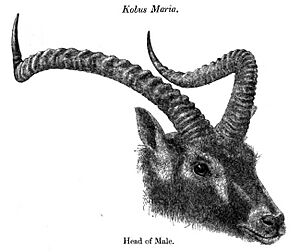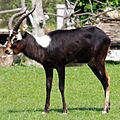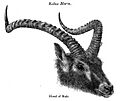Nile lechwe facts for kids
Quick facts for kids Nile lechwe |
|
|---|---|
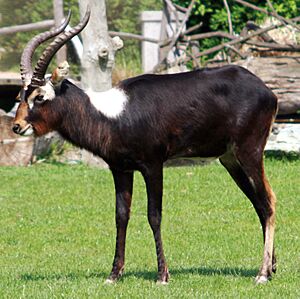 |
|
| Male | |
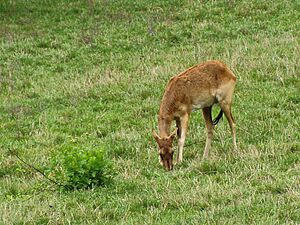 |
|
| Female Both at the Prague Zoo, Czech Republic |
|
| Conservation status | |
| Scientific classification | |
| Synonyms | |
|
The Nile lechwe (Kobus megaceros), also called Mrs. Gray's lechwe, is a type of antelope. It lives in the swamps and grasslands of South Sudan and Ethiopia. Sadly, this animal is an endangered species, meaning it is at high risk of disappearing forever.
Contents
Description of the Nile Lechwe
Nile lechwes are medium-sized antelopes. Male Nile lechwes are usually about 165 centimeters (65 inches) long. They stand about 100 to 105 centimeters (39 to 41 inches) tall at the shoulder. Males weigh between 90 and 120 kilograms (198 to 265 pounds).
Female Nile lechwes are smaller. They are about 135 centimeters (53 inches) long. Females stand about 80 to 85 centimeters (31 to 33 inches) tall at the shoulder. They weigh 60 to 90 kilograms (132 to 198 pounds). Nile lechwes usually live for 10 to 11.5 years. Some can live up to 19 years.
Their fur is shaggy, especially on their cheeks. Males and females both have long cheek hair. Males might even have longer hair on their necks. Nile lechwes show big differences between males and females, which is called sexual dimorphism. Females are golden-brown with white bellies. They do not have horns. Young lechwes are also golden-brown.
As young males grow, their fur changes to dark brown. This happens when they are two to three years old. Adult males are blackish-brown or reddish-brown. They have white 'hoods' over their shoulders. They also have small white patches above their eyes. The horns of adult males are long, about 50 to 87 centimeters (20 to 34 inches). They are strongly ridged at the bottom and curve at the tips.
Nile Lechwe Behavior and Social Life
Nile lechwes use different ways to talk to each other. They can use their bodies and make sounds. When they want to show off, they might stand tall in the air. They turn their heads to the side to display themselves. Female lechwes can be quite noisy. They make a sound like a toad croaking when they move.
When males fight, they lower their heads. They use their horns to push against each other. If one male is much smaller, he might stand next to the larger male. This way, the bigger male cannot push with all his strength.
Nile lechwes are most active in the early morning and late afternoon. This is called being crepuscular. They live in groups. Some herds can have up to 50 females and one male. Other herds are smaller and only have males.
Nile lechwes have three main social groups:
- Females and their young calves.
- Groups of young, unmarried males (bachelor males).
- Adult males with their own areas, called territories.
Sometimes, a male with a territory might let a bachelor male into his area. This helps the bachelor male guard the region.
What Nile Lechwes Eat
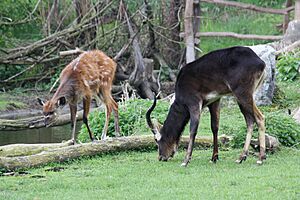
Nile lechwes enjoy eating juicy grasses and plants that grow in water. They especially like wild rice when the flood season starts. When the water goes down, they eat more swamp grasses.
These animals are special because they can walk in shallow water. They can also swim in deeper water. They might even eat young leaves from trees and bushes. They stand up on their hind legs to reach this green food. Nile lechwes are often found in marshy areas, where they find many aquatic plants to eat.
Reproduction and Life Cycle
Nile lechwes can mate throughout the year. However, most births happen between February and May. During mating season, young males sometimes bend their horns to the ground. It looks like they are poking the earth.
Males fight in the water to show who is strongest. Their heads go underwater as they push horns against each other. These fights are usually quick and rough.
A female Nile lechwe is pregnant for about seven to nine months. After this, she gives birth to one calf. Newborn calves weigh about 4.5 to 5.5 kilograms (10 to 12 pounds). A female can get pregnant again about a month after having a calf.
After birth, the mother hides her calf in thick plants for two to three weeks. She nurses it during this time. The calf stops drinking milk at five to six months old. A few months later, it is ready to live on its own and join the herd.
Where Nile Lechwes Live
Nile lechwes usually live in shallow waters next to deeper swamps. The water is often 10 to 40 centimeters (4 to 16 inches) deep. They are found only in South Sudan and Ethiopia. This means they are endemic to these countries.
In Sudan, most Nile lechwes live in the Sudd swamps. Smaller groups are found in the Machars, near the Ethiopian border. In Ethiopia, they live in the southwest, in Gambela National Park. Their homes have been badly affected by wars, people moving, and more hunting. Even their seasonal movements are limited by many cattle in their areas. However, the Nile lechwe population in the Sudd swamps has stayed somewhat steady.
Conservation Efforts
The Nile lechwe is listed as an Endangered species by the International Union for Conservation of Nature and Natural Resources (IUCN). This means they need our help to survive. In 1983, surveys from the air estimated there were 30,000 to 40,000 Nile lechwes. About 95 percent of them were in the Sudd swamps.
By 2007, the population in the Sudd region was much smaller, estimated at only 4,291 animals. This shows that their numbers have dropped quickly since 1983.
In South Sudan, Nile lechwes live in three protected areas:
- Zeraf Game Reserve: This area is about 9,700 square kilometers (3,700 square miles) along the Bahr el Zeraf river.
- Fanyikang Game Reserve: This reserve is north of the Bahr el Ghazal and covers about 480 square kilometers (190 square miles).
- Shambe National Park: This park is about 620 square kilometers (240 square miles) along the Bahr al Jabal river.
Nile lechwes move in and out of these protected areas. In Ethiopia, they are found in Gambela National Park. Experts are working on ways to protect this species, both in their natural homes and in zoos.
Images for kids



